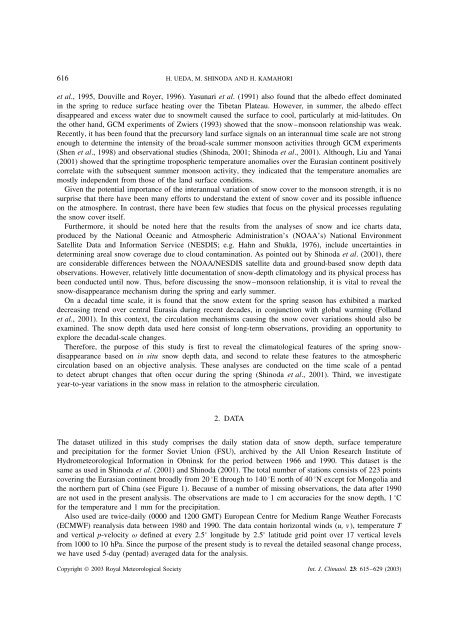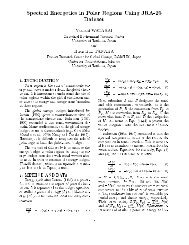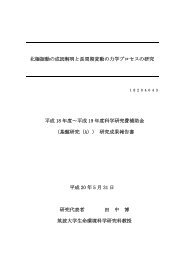Get PDF (2323K) - Wiley Online Library
Get PDF (2323K) - Wiley Online Library
Get PDF (2323K) - Wiley Online Library
You also want an ePaper? Increase the reach of your titles
YUMPU automatically turns print PDFs into web optimized ePapers that Google loves.
616 H. UEDA, M. SHINODA AND H. KAMAHORI<br />
et al., 1995, Douville and Royer, 1996). Yasunari et al. (1991) also found that the albedo effect dominated<br />
in the spring to reduce surface heating over the Tibetan Plateau. However, in summer, the albedo effect<br />
disappeared and excess water due to snowmelt caused the surface to cool, particularly at mid-latitudes. On<br />
the other hand, GCM experiments of Zwiers (1993) showed that the snow–monsoon relationship was weak.<br />
Recently, it has been found that the precursory land surface signals on an interannual time scale are not strong<br />
enough to determine the intensity of the broad-scale summer monsoon activities through GCM experiments<br />
(Shen et al., 1998) and observational studies (Shinoda, 2001; Shinoda et al., 2001). Although, Liu and Yanai<br />
(2001) showed that the springtime tropospheric temperature anomalies over the Eurasian continent positively<br />
correlate with the subsequent summer monsoon activity, they indicated that the temperature anomalies are<br />
mostly independent from those of the land surface conditions.<br />
Given the potential importance of the interannual variation of snow cover to the monsoon strength, it is no<br />
surprise that there have been many efforts to understand the extent of snow cover and its possible influence<br />
on the atmosphere. In contrast, there have been few studies that focus on the physical processes regulating<br />
the snow cover itself.<br />
Furthermore, it should be noted here that the results from the analyses of snow and ice charts data,<br />
produced by the National Oceanic and Atmospheric Administration’s (NOAA’s) National Environment<br />
Satellite Data and Information Service (NESDIS; e.g. Hahn and Shukla, 1976), include uncertainties in<br />
determining areal snow coverage due to cloud contamination. As pointed out by Shinoda et al. (2001), there<br />
are considerable differences between the NOAA/NESDIS satellite data and ground-based snow depth data<br />
observations. However, relatively little documentation of snow-depth climatology and its physical process has<br />
been conducted until now. Thus, before discussing the snow–monsoon relationship, it is vital to reveal the<br />
snow-disappearance mechanism during the spring and early summer.<br />
On a decadal time scale, it is found that the snow extent for the spring season has exhibited a marked<br />
decreasing trend over central Eurasia during recent decades, in conjunction with global warming (Folland<br />
et al., 2001). In this context, the circulation mechanisms causing the snow cover variations should also be<br />
examined. The snow depth data used here consist of long-term observations, providing an opportunity to<br />
explore the decadal-scale changes.<br />
Therefore, the purpose of this study is first to reveal the climatological features of the spring snowdisappearance<br />
based on in situ snow depth data, and second to relate these features to the atmospheric<br />
circulation based on an objective analysis. These analyses are conducted on the time scale of a pentad<br />
to detect abrupt changes that often occur during the spring (Shinoda et al., 2001). Third, we investigate<br />
year-to-year variations in the snow mass in relation to the atmospheric circulation.<br />
2. DATA<br />
The dataset utilized in this study comprises the daily station data of snow depth, surface temperature<br />
and precipitation for the former Soviet Union (FSU), archived by the All Union Research Institute of<br />
Hydrometeorological Information in Obninsk for the period between 1966 and 1990. This dataset is the<br />
same as used in Shinoda et al. (2001) and Shinoda (2001). The total number of stations consists of 223 points<br />
covering the Eurasian continent broadly from 20 °E through to 140 °E north of 40 °N except for Mongolia and<br />
the northern part of China (see Figure 1). Because of a number of missing observations, the data after 1990<br />
are not used in the present analysis. The observations are made to 1 cm accuracies for the snow depth, 1 °C<br />
for the temperature and 1 mm for the precipitation.<br />
Also used are twice-daily (0000 and 1200 GMT) European Centre for Medium Range Weather Forecasts<br />
(ECMWF) reanalysis data between 1980 and 1990. The data contain horizontal winds (u, v), temperature T<br />
and vertical p-velocity ω defined at every 2.5° longitude by 2.5° latitude grid point over 17 vertical levels<br />
from 1000 to 10 hPa. Since the purpose of the present study is to reveal the detailed seasonal change process,<br />
we have used 5-day (pentad) averaged data for the analysis.<br />
Copyright © 2003 Royal Meteorological Society Int. J. Climatol. 23: 615–629 (2003)
















